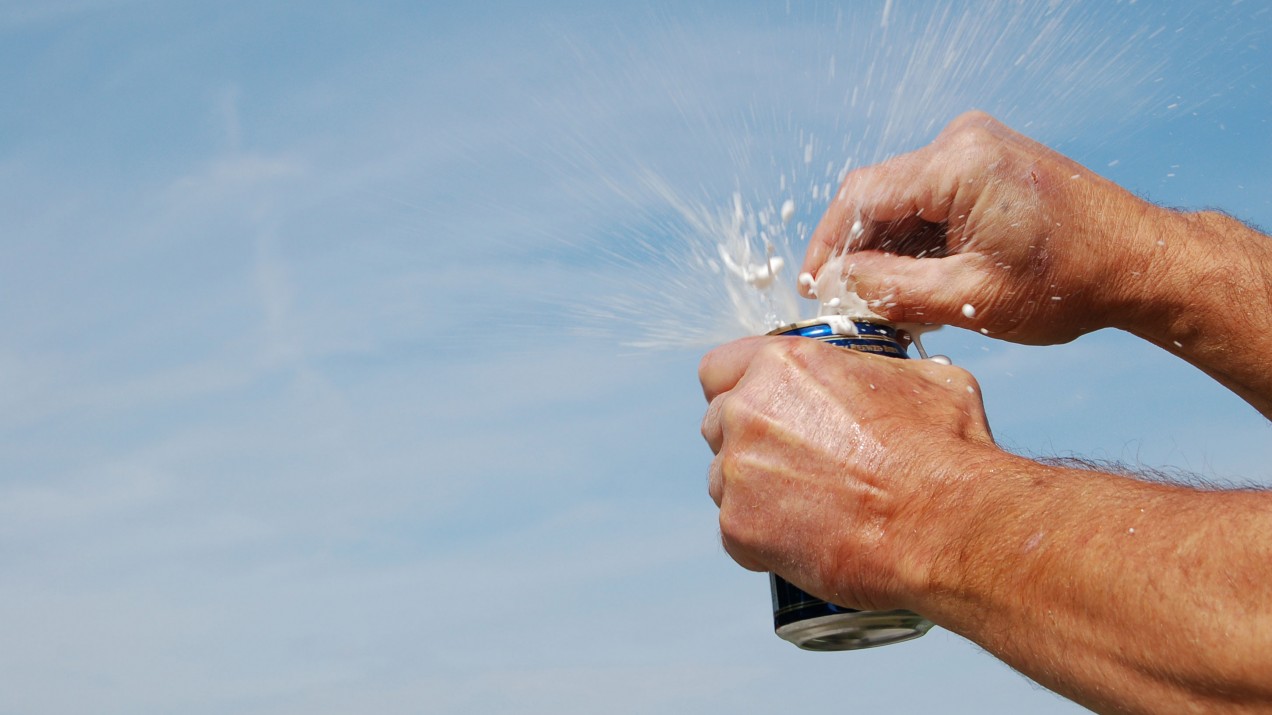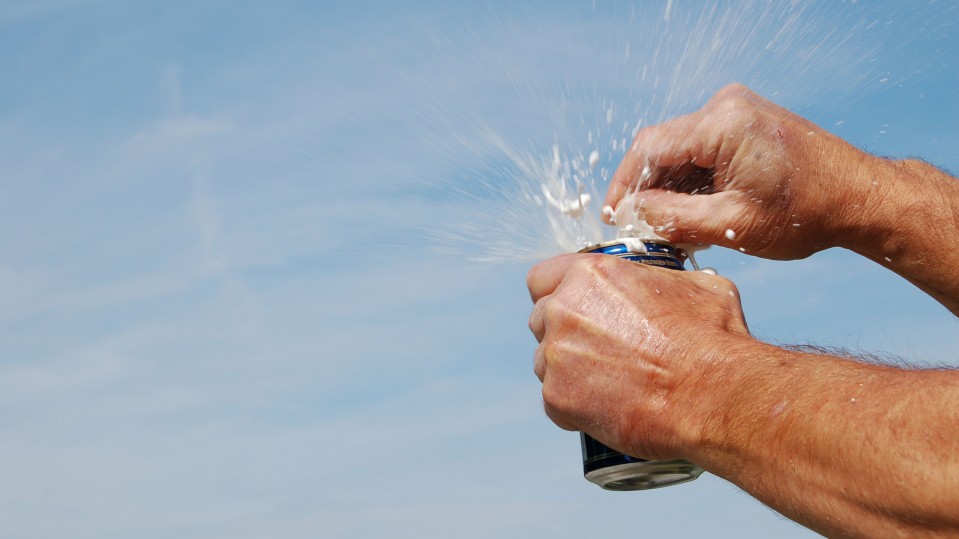

Humans and Technology
Does tapping the bottom of a beer can really stop it fizzing over?
Dedicated researchers have the answer.

Among the great questions in science, one stands sadly neglected: Is it possible to stop a shaken beer can from foaming by tapping it before opening?
There are good theoretical reasons to think this should work. The tapping should release any bubbles that are stuck to the inside walls of the can. These should then float to the surface and dissipate, making the beer less likely to foam when it is opened. But is this true?
Today, we get an answer thanks to the selfless work of Elizaveta Sopina at the University of Southern Denmark and a few colleagues. This group has tested the theory for the first time using randomized controlled trials involving 1,000 cans of lager. And luckily for the research team, the result raises at least as many questions as it answers, ensuring a strong future for beer-related research.
First some background. Beer is a water-based fermented liquid containing alcohol and proteins from ingredients such as barley and hops. It is often carbonated with high-pressure carbon dioxide gas and then stored under pressure.
Releasing this pressure dramatically reduces the amount of carbon dioxide the liquid can hold, causing bubbles to form. When the bubbles rise to the surface of the liquid, proteins stabilize the resulting foam, leading to the formation of a creamy head that is characteristic of many beers. The head helps to trap flavor molecules that give beers their unique tastes and smells.
The problem with foaming arises when beer is shaken before opening. Shaking increases the surface area of the beer inside the can and allows carbon dioxide to desaturate. The gas forms tiny bubbles centered on small particles in the liquid, known as nucleation centers.
When the can is opened, these bubbles grow rapidly in size and rise to the surface, creating foam. When this foam occupies a greater volume than there is space at the top of the can, the beer overflows. “This is inefficient, as fizzing reduces the amount of beer available for consumption and results in waste,” say Sopina and co. “Beer spray can also stain clothes or surrounding objects, and therefore is also an unpleasant and socially undesirable side-effect.”
With more than 170 billion liters of beer consumed every year (much of it by researchers in Denmark, presumably), the scale of the problem is easy to see. “Preventing, or, at least, minimizing beer fizzing is both socially and economically desirable,” say Sopina and co.
That’s where the tapping theory comes in. There is no shortage of anecdotal evidence that this techniques either works wonders or is entirely ineffective. “Given the strong Danish tradition in beer brewing and consumption, we set out to settle this matter with high-quality evidence,” say the team.
They began with the impressive achievement of persuading a local brewery to donate 1,031 cans of Pilsner-style beer for “research purposes.” After “losses” of various kinds, they were able to gather data from 1,000 cans on which to base their results.
The experiment was straightforward. The team cooled the cans in a fridge to drinking temperature and randomly divided them into two groups—those to be shaken and those not to be shaken. They further subdivided each group into cans that would be tapped and those that would be left untapped. They labeled the base of each can appropriately so no researcher involved in the shaking and tapping could easily tell them apart, even subconsciously.
The cans were then shaken using a “Unimax 2010 shaker” for two minutes at 440 rpm. “Pilot testing revealed that this shaking method successfully mimicked carrying beer on a bicycle for 10 minutes—a common way of transporting beer in Denmark,” says Sopina and co. Unwanted foaming must be at epidemic levels there.
The researchers then weighed each can, tapped it by flicking it three times on its side with a finger, and then opened it. Finally, they weighed the can again to determine the amount of beer that had been lost.
The results are palate tickling. Sopina and co compared the amount of beer lost for tapped and untapped cans that had been shaken and found no statistical difference—both lost about 3.5 grams of liquid to foaming.
They also found no meaningful difference between the cans that had not been shaken—when opened, they lost about 0.5 grams on average.
The obvious conclusion is that can tapping does not reduce foaming, a result that must be a considerable disappointment for bicycle-riding, beer-carrying Danes.
However, this negative result raises an interesting question of its own: Why doesn’t tapping work? And Sopina and co have some ideas. One is that flicking does not provide enough energy to dislodge bubbles, perhaps because the energy is absorbed by the aluminium can and the bulk of the liquid. Unfortunately, the team does not appear to have measured the energy imparted in this way, cleverly leaving the way open for more research.
Another possibility is that an assumption behind the tapping theory—that the bubbles associated with foaming must be attached to the wall of the can—is incorrect. “If most bubbles are located in the bulk liquid, the surfacing of the wall-adhered bubbles by flicking would be insignificant compared to the rapid surfacing of the bubbles in the bulk liquid,” say the team.
Finally, it may be that the microbubbles become trapped in the liquid by the same proteins that contribute to a beer’s creaminess. That would prevent them from rising at all. If that’s the case, the tapping method may still work for other fizzy drinks that do not contain these molecules. Indeed, some anecdotal evidence supports this.
If proteins are responsible, Sopina and co suggest that beer could be treated to prevent foaming by denaturing the relevant proteins, perhaps by heating the beer before it is cooled. However, the proteins play an important role in the flavor and mouthfeel of beer. “The potential negative impact on the sensory experience of the beer consumption and the risk of applying heat to a sealed pressurized metal container are important future research topics to be answered,” say the team.
And therein lies an entirely new research project for Sopina and her colleagues, or indeed any other specialists. Beer-related research is a glass that is truly bottomless.
Ref: arxiv.org/abs/1912.01999 : To Beer Or Not To Beer: Does Tapping Beer Cans Prevent Beer Loss? A Randomised Controlled Trial.